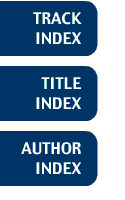
Track: Agriculture
Animated Map Proposal of the Cerrado Region in Brazil
Antoinette WanneboThe Cerrado region of Brazil is undergoing rapid land use change as poor pastures and poor soils are being converted to commercial pastures and intensive agricultural areas. Grasses such as Bracchiaria are being planted to improve pastures, and high inputs such as lyme and fertilizer are supporting intensive commercial soybean, corn, and wheat cultivation. We are studying the impact of interannual climate variability, such as ENSO events, on agricultural systems in the Cerrado region. We are linking AVHRR NDVI and Landsat MSS and TM satellite data, the Cane-Zebiak ENSO prediction model, the GISS general circulation model, and the ICASA dynamic crop models to improve the usefulness of ENSO predictions for agriculture. The Cerrado region is one of six study regions in this project. AVHRR NDVI values will be used to determine those agricultural areas affected by ENSO. The rapid rate of land conversion to agriculture in the Cerrado region since the 1970s limits the usefulness of existing maps to correctly identify changing agricultural areas for our study area over the time period of interest (1972-1997). It is important to clearly delineate agricultural areas for each year to isolate the impacts of interannual climate variability from anthropogenic influences such as increased land devoted to agriculture. To fulfill our need to correctly identify agricultural regions for each year, we are building a dynamic animated map chronicling agricultural land use changes in the Cerrado region. We are integrating information from existing soil, vegetation, and land use maps; MSS and TM images; and aerial photographs into a GIS system. Using ArcInfo, an initial basemap of agricultural areas in the 1970s will be created. Information from relevant data sources will then be incorporated into the ArcInfo database to create annual maps chronicling agricultural expansion over a quarter century (1972-1997). A GUI for ArcView GIS will be developed so that the database can be queried to display agricultural regions and associated NDVI signals for a given year. This feature will assist in identifying spatial and temporal patterns of agricultural land use change. The map will be publicly available over the Internet and will help in understanding the dynamic nature of land use in this region in addition to being an invaluable resource to agronomists, ecologists, sociologists, and economists.
Antoinette Wannebo
NASA/GISS
,
Telephone: 212-678-5640
Fax:
E-mail: awannebo@giss.nasa.gov